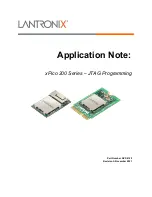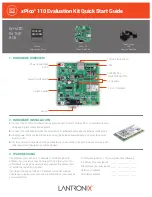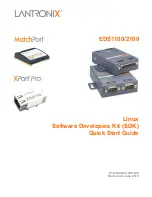External Bus Interface (EBI)
MPC5510 Microcontroller Family Reference Manual, Rev. 1
29-42
Freescale Semiconductor
Preliminary
29.4.2.8
Arbitration
The MPC5510 does not support arbitration.
29.4.2.9
Termination Signals Protocol
The termination signals protocol was defined to avoid electrical contention on lines that can be driven by
various sources. To do that, a slave must not drive signals associated with the data transfer until the address
phase is completed and it recognizes the address as its own. The slave must disconnect from signals
immediately after it acknowledges the cycle and not later than the termination of the next address phase
cycle.
For EBI-mastered non-chip select accesses, the EBI requires assertion of TA from an external device to
signal that the bus cycle is complete. The EBI uses a latched version of TA (1 cycle delayed) for these
accesses to help make timing at high frequencies. This results in the EBI driving the address and control
signals 1 cycle longer than required, as seen in
. However, the data (AD) does not need to be
held 1 cycle longer by the slave, because the EBI latches AD every cycle during non-chip select accesses.
During these accesses, the EBI does not drive the TA signal, leaving it up to an external device (or weak
internal pullup) to drive TA.
For EBI-mastered chip-select accesses, when the SETA bit is 0, the EBI drives TA the entire cycle,
asserting according to internal wait state counters to terminate the cycle. When the SETA bit is 1, the EBI
samples the TA for the entire cycle. During idle periods on the external bus, the EBI drives TA negated as
long as it is granted the bus; when it no longer owns the bus, it lets go of TA. When an external master
does a transaction to internal address space, the EBI only drives TA for the cycle it asserts TA to return
data and for 1 cycle afterwards to ensure fast negation.
If no device responds by asserting TA within the programmed timeout period (BMT in EBI_BMCR) after
the EBI initiates the bus cycle, the internal bus monitor (if enabled) asserts TEA to terminate the cycle. An
external device may also drive TEA when it detects an error on an external transaction. TEA assertion
Table 29-17. Data Bus Contents for Write Cycles
Transfer
Size
TSIZ[0:1]
1
1
TSIZ is not enabled on the MPC5510.
Address
32-Bit Port Size
16-Bit Port Size
2
2
Also applies when DBM=1 for 16-bit data bus mode.
A30
A31
D0:D7
D8:D15
D16:D23
D24:D31
D0:D7
D8:D15
Byte
01
0
0
OP0
—
—
—
OP0
—
01
0
1
OP1
OP1
—
—
—
OP1
01
1
0
OP2
—
OP2
—
OP2
—
01
1
1
OP3
OP3
—
OP3
—
OP3
16-bit
10
0
0
OP0
OP1
—
—
OP0
OP1
10
1
0
OP2
OP3
OP2
OP3
OP2
OP3
32-bit
00
0
0
OP0
OP1
OP2
OP3
OP0/OP2
3
3
This case consists of two 16-bit external transactions, the first writing OP0 and OP1, the second writing OP2 and OP3.
OP1/OP3


















